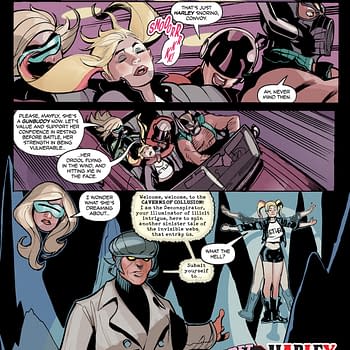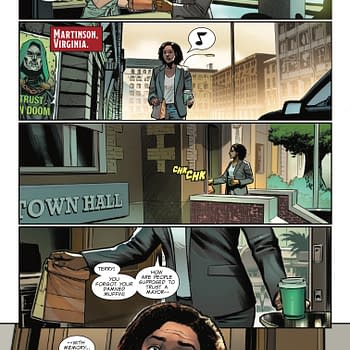Posted in: Comics, NYCC | Tagged: charity, Comics, entertainment, hero initiative, NYCC
We Looked At Hero Initiative's Finances – And What We Found May Surprise You

The charity that raises funds to help out veteran comic book creators in financial straits is everpresent in the comic book industry. With senior figures on its board, working with the likes of Marvel and DC, it is a lifeline to many and a salve for the industry. But what it does may actually be out of kilter with what people think it does – I know it was so for me.
In 2012-2013, three times as much money was spent on salary, namely $120,909, as was spent on grants to the needy, namely $32,218. While that smaller amount only just beat the amount spent on travel expenses, it was out of total expenses of $125,814. Total revenue was $286,186 and there was $7,245 remaining in the fund at the end of the year. Of the total revenue raised, only 15% went directly in grants to comic book creators in need. And, yes, that surprised me.
It's not like this is new, things just have been getting more pronounced. The first reported figures from 2008-2009 see salaries beat out grants by just 20%, in 2009-2010 by 80%, then in 2010-2011 it was up to 300%. 2011-2012 saw that back down to 50% but in 2012-2011, back up to the 300% that we also see in 2012-2013. It does feel like a disconnect to see three times as much money regularly spent on salaries as directly given to creators.
I talked to Hero Initiative president Jim McLauchlin who told me:
The long story short is that there's always a cash reserve on hand, which is pretty CRITICALLY important, as very, very, very often, the calls we get are from someone 24 hours or so from eviction with three months back rent to pay. These are things that need to be acted on as soon as possible. That cash reserve effectively "carries" on a balance sheet, so you might see something in any given year that looks like a lower percentage. But the reserve is still there, and can be used to action.
In the last 15 days alone, I sent $200 grocery cards to two people, $4750 to an artist who suffered a house fire in the home where he cares for his elderly father (the Red Cross got them a motel for three nights and then said, "that's all we can do"), $425 on some simple Russ Heath maintenance, $2000 to Tom Ziuko to help him as he recovers from yet another circulatory surgery, $1400 to Karl Moline to get him over the hump of missed work and behind-on-rent as he's still bouncing back from a kidney and pancreas transplant, $510 to a tax professional who's helping a creator with back-tax problems, and $353 to the gas company for another creator whose service was about to be shut off. To these people, that cash-on-hand is very important.
We file our Form 990 every year, which is the "tax return" for nonprofits. Everything we do is fully compliant with the IRS for section 501 (c) (3).
We have two employees and zero office space. We have weekly meetings at the Bob's Big Boy on Riverside Dr. in Toluca Lake. We do have a storage locker for extra product, booth pop-ups, etc. That's $155 a month.
I asked him about the figures mentioned at the top. He told me,
Clearly every year is different in both money in and money out. We have exactly two employees, which is about as close-to-the-bone as I can find to run an organization that provides direct financial aid, medical services, financial services, and legitimate casework. The good news is, there's a cash reserve on hand. Money is still there, which is put into action regularly (as was shown in previous example).
Jim is citing the work of affiliated doctors, accountants and lawyers that help out creators in need directly, a less publicised aspect of the Hero Initiative's work. Is that where the money goes? Again, not directly, Jim elaborated that they are:
almost NEVER paid. Almost invariably, they're providing their services for free, but that takes time, effort, cultivation, coordination, and administration on our part. On a small for-instance, Russ Heath, who is 89 years old and cannot drive any longer, gets free medical appointments and free transportation to and from, but we need to handle logistics, and sometimes drive the car. On a much larger level, Program Services recipients have received major orthopedic operations and actual cancer treatments at NO cost to them. I'd posit that these services are of MAJOR import to the recipients, although at the cost of "free," they may not specifically show up on a balance sheet.
And when they do, they can be of equal import. In June, 2015, Joe Phillips was caught in an insurance snafu of Olympian proportions. Joe had a leg amputated in 2014, and had a temporary prostheses as his stump has healed and formed. He was slated to get his permanent one installed on June 18, 2015. Joe had obtained insurance through the Affordable Care Act, and per the terms of that plan, he could NOT change that insurance until November, 2015. And he was in the WRONG plan, that did not cover his prostheses (insanely enough).
Bottom line, Hero paid $5132 direct to the supplier to get Joe his new artificial leg (which, by nature of the beast, was a custom fit jobs and was at the ready, awaiting payment). Joe didn't have the money, and his only alternative was to wait five months to change insurance plans. Joe is walking today, and has lost about 70 pounds in weight. He's doing way better.
All these things are "baked in" to what Hero Initiative does.
That's the thing. Hero Initiative does sell itself through the direct grants it hands out, but it does do more, it does travel from show to show, it raises awareness as well as revenue ,and it provides services to creators as well as the necessary cash.
It's just not exactly what I thought it was. Worth the donation (and I just have made one). But if you are solely interested in helping creators financially directly, maybe keep an eye on GoFundMe as well. Of course that kind of fundraising is only for those who can organise it well themselves, and Hero manages that for others.
Hero Initiative will be exhibiting this week at NYCC, Booth #N104, with the following projects and signing schedules.
Here are the most recent 2012-2013 figures if you want to check them out yourself.
















